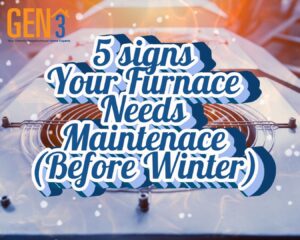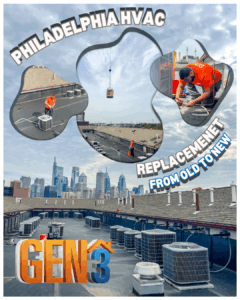The holiday season sparkles with twinkling lights and colorful decorations. However, this magical time can quickly turn dangerous if we’re not careful when dealing with your electrical system.
Overloading circuits is a common holiday hazard that can lead to electrical fires or damage to your home’s system. Proper planning and safe lighting practices can keep your festive displays glowing safely without risk to your well-being or electrical network.
From the start of our business over twenty years ago, our mission at GEN3 Electric & HVAC has been to help homeowners across the Philadelphia region live comfortably and safely. We carry out this mission through the quality of our work and the level of education we provide to our customers about their home systems. That’s why we’re here with our comprehensive guide full of holiday lighting safety tips you can follow year after year. Reach out to us today with any questions or to book a service. From electrical repair to circuit restoration and even panel upgrades, we have something for everyone.
Understanding Electrical Circuit Capacity
Electrical circuits form the backbone of any home’s system, distributing power throughout the household. These circuits allow your home’s appliances, lights, and devices to operate. In each circuit, power flows from the main service panel, often called the breaker box, and supplies electricity to different areas or specific appliances. Every home has circuits designed to carry a maximum amount of electrical load, measured in amperes. Overloading occurs when too many lights or devices pull more power than the circuit was built to handle.
Many homes feature 15-amp or 20-amp circuits, often running several rooms or outlets. Adding extra holiday decorations, especially if outdoor lights or large displays are involved, can quickly increase the electrical load. Using high-wattage decorations like incandescent lights, for instance, could push circuits beyond their limits. Circuits unable to handle the added strain will trip the breaker or, worse, overheat and cause an electrical fire.
Identifying Your Home’s Electrical Capacity
Determining your home’s electrical capacity doesn’t require an engineering degree. Start by locating your main electrical panel. You’ll typically find it in your basement, garage, or utility room. Look for labels on each circuit breaker indicating the amperage — most commonly 15 or 20 amps. Most breaker boxes have labels indicating the amperage for each circuit. For example, a typical 15-amp circuit can handle around 1,800 watts, while a 20-amp circuit can handle about 2,400 watts.
Next, calculate the wattage of your holiday decorations. Many decorations list their wattage on the packaging or cord tag. As a rule of thumb, you can safely use up to 80% of a circuit’s capacity. For a 15-amp circuit, that’s about 1,440 watts, while a 20-amp circuit can handle up to 1,920 watts.
Common Causes of Circuit Overload During Holidays
Holidays bring out everyone’s inner decorator, but festive enthusiasm sometimes leads to poor planning when it comes to electrical safety. One common issue is too many lights concentrated on one circuit. If you plug several strings of incandescent lights, outdoor inflatables, and other electrical decorations into the same outlet or power strip, you’re likely to exceed the capacity of that circuit.
Other common mistakes include daisy-chaining extension cords or plugging extension cords into power strips that were never intended for high-wattage loads. This increases the risk of electrical shocks or fires, especially when combined with aging electrical systems.
Tips for Safe Holiday Lighting
Adopting a few holiday lighting safety tips will not only protect your home from electrical hazards but will also allow you to enjoy a more energy-efficient display. Here are some practical ways to avoid overloading circuits and keep your family safe.
Get LED Lights to Reduce Energy Consumption
Switching to LED Christmas lights remains one of the simplest ways to reduce your energy consumption while keeping your home bright and festive. They consume far less power than traditional incandescent lights. This means you can string together several sets of LED lights without significantly increasing the electrical load on your home’s circuits. They also run cooler, reducing the risk of electrical fires or heat damage to holiday decorations.
Properly Distribute Lights Across Circuits
Proper planning prevents circuit overload. Take note of how many outlets each room or outdoor space has, and spread your holiday lighting across multiple circuits. You can identify separate circuits by switching off individual breakers in your panel to see which lights or appliances shut off. Once you know which outlets belong to which circuit, distribute your lights, inflatables, and other holiday decorations accordingly.
Avoid Daisy-Chaining Extension Cords
Daisy-chaining, or connecting multiple extension cords together, presents a serious fire hazard. Extension cords are rated to handle a specific load, and connecting several together increases the chances of an electrical overload. Instead of daisy-chaining, use a heavy-duty extension cord rated for outdoor lights, and make sure the wattage of your holiday decorations stays below the cord’s limit.
Utilize Surge Protectors & Timer Switches
Surge protectors act as a safety net for your holiday lights and decorations. They help protect against sudden power surges that could damage your festive display or, worse, start a fire. Timer switches offer an added layer of convenience and safety, automatically turning off your lights when you’re asleep or away from home.
Electrical Safety Precautions for Holiday Lighting
While decorating with lights brings joy to your home, it’s important to keep electrical safety in mind. Holiday lights should always be kept away from flammable materials such as curtains, dry trees, or cardboard decorations. Both indoor and outdoor lights should be checked regularly for damaged wiring, broken bulbs, or faulty connections.
When installing holiday lights outdoors, use outdoor-rated extension cords and fixtures. Indoor lights, while often less vulnerable to moisture, should still be monitored for frayed wires or other damage. Replacing faulty bulbs or worn-out strings also guarantees your holiday display doesn’t turn into a fire hazard.
Signs of an Overloaded Circuit
Recognizing the warning signs of an overloaded circuit can prevent electrical fires and keep your holiday cheer intact. Watch out for:
- Flickering or dimming lights
- Warm or discolored wall plates
- Burning odors from outlets or switches
- Buzzing sounds from outlets or switches
- Frequently tripping circuit breakers
If you notice any of these signs, immediately unplug some devices and redistribute the load across different circuits.
When to Call a Professional
Sometimes, holiday lighting ambitions outgrow our home’s electrical capacity. If you’re experiencing frequent breaker trips, noticing warm outlets, or simply feeling unsure about your system’s ability to handle your holiday display, it’s time to call in the pros.
A licensed electrician can perform a thorough safety inspection of your electrical system. They might recommend upgrades like installing additional circuits or a sub-panel to accommodate your holiday lighting needs safely. Remember, electrical work isn’t a DIY project — always consult with a professional to avoid potential hazards.
Want More Holiday Light Safety Tips? Call GEN3 Electric & HVAC!
The holiday season offers many reasons to celebrate. With the right planning and attention to electrical safety, your home can shine brightly while keeping your family and property safe. Following these holiday lighting safety tips will help ensure your festive display remains beautiful without risking overloading your circuits.
For more tips and tricks, or to book an appointment with one of our licensed electricians, give our GEN3 Electric & HVAC team a call today!





